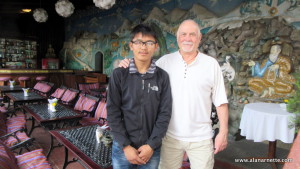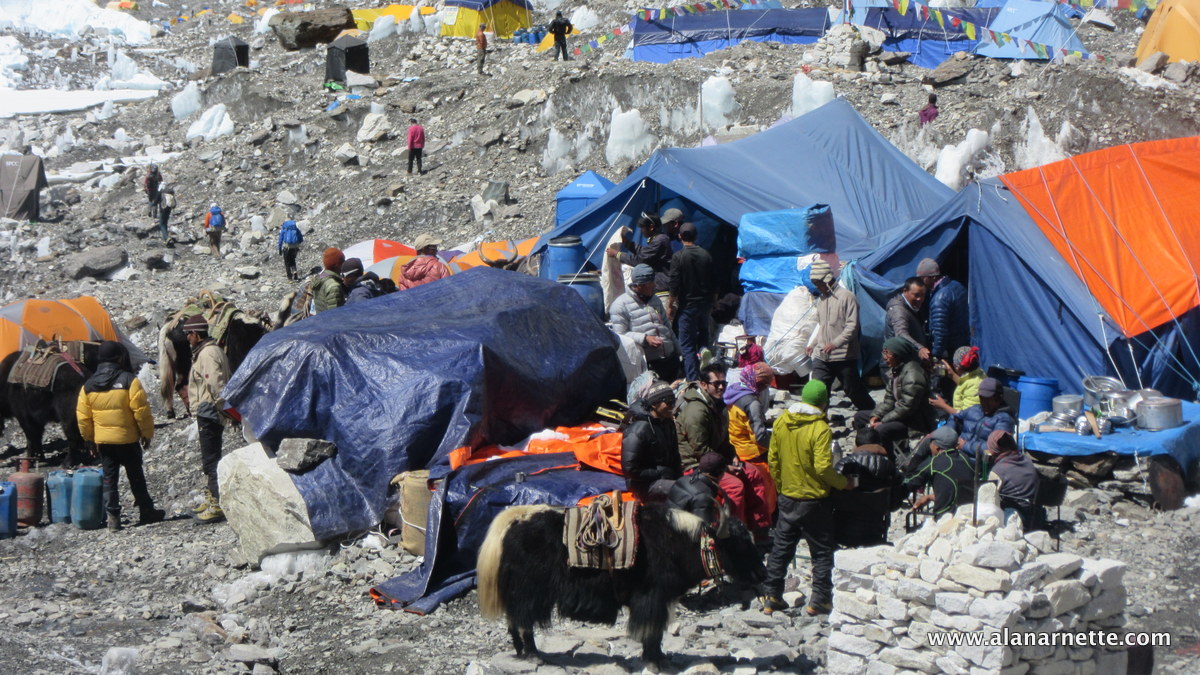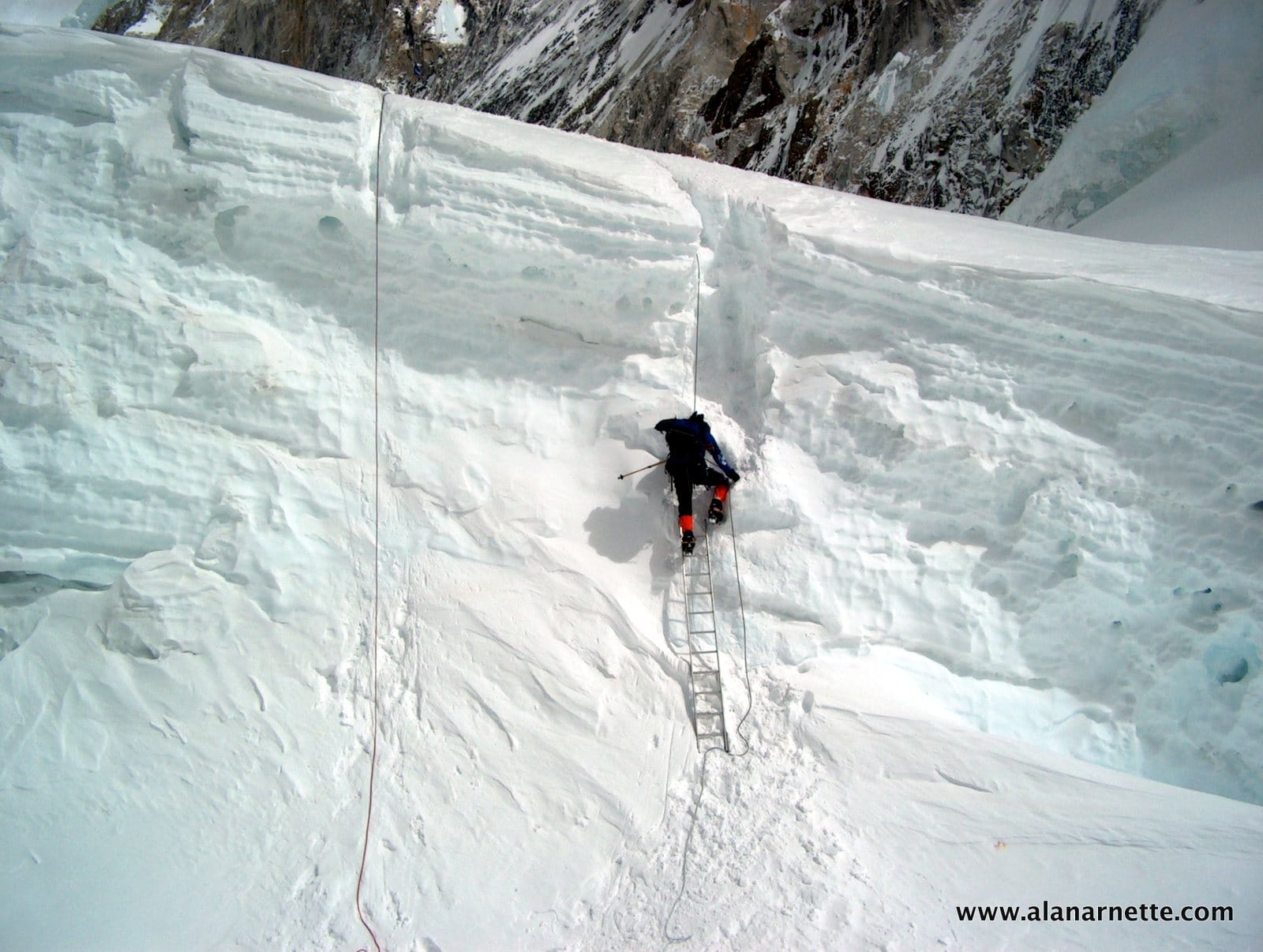April 18, 2014 at 6:35 am, a small section of a long standing feature on the West Shoulder of Everest, aka an objective hazard, released onto the Khumbu Icefall. 16 Sherpas were killed in a moment as tons of ice and snow fell, leaving the mountain workers with few options and nowhere to hide. For today, two years later, there is no climbing on Mt. Everest. No Sherpas, no foreigners – everyone is in solemn unity remembering where they were that day, and who they lost.
“The tears are right below the surface.” Russell Brice, Himex, told me this morning while standing on the trail that defines main street of Everest Base Camp. Brice’s words and emotions could have come from any Everest operator – foreign or Nepali. Many lost long time employees, friends and in many cases, family. There is no chasm between the operators or agencies. They speak in quiet tones about great climbers, young and old Sherpa Guides. They talk about their base camp doctors or the cameraman trying to record what makes Everest so special. Avalanches know no profession, no nationality. They are random and often fatal.
Brice and others – western and Nepali – are back in 2016. When asked why, he simply says “It’s the right thing to do.” The cynical will bring into the conversation how much Sherpas are paid, the profit margins and the tired old line about Sherpa exploitation by western operators.
If you ask the Sherpas, they will acknowledge the danger and the income that comes from guiding. They are pleased that about 300 foreigners are climbing Everest in 2016. That were worried that the bad publicity around Everest after the fights in 2013, the avalanches in 2014, earthquake in 2015 and the embargo in 2016 would scare away tourism. They may have been right about the trekkers as they are scarce but the climbers continue to come to the world’s highest mountain – whatever their motivation.
The team I’m with, Altitude Junkies, hired 13 climbing Sherpas, 7 cooks and countless porters. We stayed in Kathmandu hotels and ate in Kathmandu restaurants. As we trekked towards base camp we stayed in teahouses, ate our meals there. The medical, life and rescue insurance fees goes to Nepali companies. Our gear was transported from Kathmandu to the Khumbu on Nepali owned airlines. Local porters carried them further up valley. Yes, the $11,000 Everest permit fee goes to the government and the western and Nepali companies earn a profit however a large part of the revenue, both direct and indirect that a climber pays, goes right back into Nepal.
This is why Brice, and other operators are back. They know that what they do goes beyond helping members stand on a summit.
Today’s remembrance is not a justification for climbing. It is not a marketing ploy to attract more climbers or sympathy. It is not an opportunity for another “adventure” magazine to sell advertising based on reciting decades old myths that are no longer valid.
However, to be clear, not much has changed for the mountain workers other than increased life insurance. But the fault lies not with Western Operators as is often cited – in fact they have supported their staffs in levels high above the non-enforced laws. The fault lies with the Nepali Ministry of Tourism which has had three different Ministers in the last 12 months, not unusual. A fractured government and a diverse ethnic population prevents further progress for the Sherpa people, and others who work in mountains. The Sherpa people are viewed as already having a lucrative lifestyle and incomes by the rest of Nepal. These views generate jealousy and stalls further advances in safety and wages by the Ministry of Tourism.
But these facts are ignored and the complexities are real. A solution is not simple. Yes, climbers can stop climbing Everest, but what would that accomplish and who would suffer the most?

While in Kathmandu, I met with Kami Sherpa’s son. I summited Everest and K2 with Kami and stood side by side in the Western Cwm during last year’s earthquake
Kami’s son, Mingma, is an impressive young man. He is now 21 and has one year left to obtain his Electrical Engineering degree in Kathmandu. He hopes to work for a hydroelectric company.
Mingma said he wanted to be a mountain guide like his Grandfather, father and second oldest brother but Kami wouldn’t let him. He said he liked the idea of adventure. Interestingly, his mountain guide brother makes fun of Mingma for going to school and not earning as much money as he does guiding ….
His two sisters also go to school in Kathmandu. One wants to be a doctor, the other is majoring in Hospitality Management.
By the way, Mingma’s English is perfect. He was born in the stone house where Kami and Lhapka live today, like all his brothers and sisters. He went to grades 1-5 in Pangboche then to the Hillary school in Kumjung to grade 7. When Kami sent him to boarding school in Kathmandu, they dropped him back to grade 5 because his English was so poor. He went on to graduate high school and is now at the university.
The pressure is huge for them to stay in the Khumbu and make a few quick dollars guiding for 2-4 months a year but Kami wanted a better life for his younger children – and he is seeing that come true. Mingma’s tuition is about US$2,000 a year, his sisters about $600 each. Most Sherpas employed by western guide companies will make about $5,000 guiding this spring, the low-end Nepali guide companies will pay their staff half or less for the same work
Kami’s hard work is benefiting his children. He has the same dream as parents everywhere – for their children to have a better life than they do.
Today is a day of memories. A day where a family in Portse, Pangboche or Thame remembers their fallen husband, son or father. They are grateful for his sacrifice that allowed his children to receive an education – something he never had. They are grateful that his son or daughter will not become an Everest guide. They understand the juxtaposition between risk and reward. They understand that mountains are dangerous and if they had alternatives, they would take it. And that their children might never choose this way to support their families.
Their tears are real and visible; others are under the surface waiting to hear a name.
Today is a day of memories, and dreams.
Climb On!
Alan
Memories are Everything




3 thoughts on “Everest/Lhotse 2016: Tears Right Below the Surface”
Thank you for this post, Alan. I appreciate hearing a perspective on Everest that is rarely covered in the media.
Beautifully written. I hope our words reach millions.
I too wish more people could undertand the real situation in Nepal climbing.
Comments are closed.